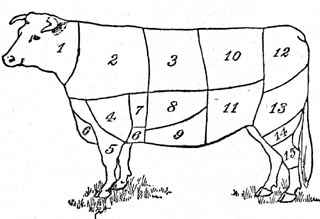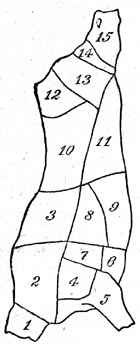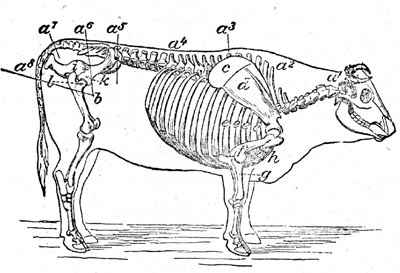
|
 |
Make a Careful Study of the Above Diagrams.
NEGenWeb
Project
Resource Center
Schools
|
132 |
|

|
 |
Make a Careful Study of the Above Diagrams.
|
|
133 |

Fig. 10. Location of the Bones in the Various Cuts of Meat.
a1 to a2, neck; a2 to a3, six chuck ribs; a3 to a4, seven prime ribs; a4 to a5, loin or porterhouse; a5 to a6, thick or hip sirloin; a6 to a8, rump piece; a7, where rump is divided into top and tail end; c d, shoulder-blade; e, e, e, e, cross-rib piece; f, g, bones in shoulder of beef; h, sternum; I, head of thigh-bone; k, socket; l, ball.
It is very important to spend considerable time in study of the two preceding diagrams, carefully fixing in mind the various cuts of meats.
Meat contains a large amount of albumen, and should therefore be subjected to long, slow cooking after searing the surface to preserve the meat juices.
The tougher and therefore cheaper cuts of meat are more easily digested if properly cooked. They are cheaper for two reasons: Their first price is lower and there is much less waste. It will be observed by looking at the chart that the most tender and finest grained meat is cut from muscles which are least used.
Season with salt and pepper, dredge in flour, and brown the entire surface of a four or five pound piece from the rump or round. Put in kettle, add water to half cover meat, cover closely, and keep just below boiling point for four hours. When done, remove meat; strain liquid and thicken for gravy.
|
134 |
|
2 c flour
1/2 tsp salt
4 tsp baking powder
2 tsp butter
3/4 c milk
Mix and sift dry ingredients. Work in butter with tips of fingers, add milk gradually, using a knife for mixing. Toss on a floured board, pat, and roll out to one-half inch in thickness. Shape with biscuit cutter, first dipped in flour. Place closely together in a buttered steamer put over kettle of boiling water, cover closely, and steam twelve minutes. A perforated tin pie plate may be used in place of steamer.
The best cuts of beef for roasting are: Tip or middle of sirloin, back of rump, or first three ribs.
"Wipe meat; put on a rack in dripping pan, skin side down, rub over with salt; and dredge meat and pan with flour. Place in hot oven, that the surface may be quickly soared, preventing escape of inner juices. After flour in pan is browned, reduce heat, and baste with fat which has tried out; if meat is quite lean it may be necessary to put trimmings of fat in pan. Baste every ten minutes; if this rule is followed meat will be found more juicy. When meat is about half done, turn it over and dredge with flour that skin side may be uppermost for final browning. A five pound roast will require about two hours' roasting."
Remove some of fat from pan, leaving three tablespoons flour, and stir until well browned. The flour, dredged and browned in pan, should give additional color to gravy. Add, gradually, one and one-half cups boiling water; cook five minutes; season with salt and pepper; strain.
1 c milk
2 eggs
1 c flour
1/4 tsp salt
Mix salt and flour, and add milk gradually to form a smooth paste; then add eggs beaten until very light. Cover bottom of pan with some of beef fat tried out from roast; pour mixture in pan one-half Inch deep. Bake twenty minutes in hot oven, basting after well risen.
After spending considerable time studying the charts drawing meat charts, and naming the parts, it is well to visit a meat market or cellar where meat may be examined. The local butcher is very glad to give a meat demonstration if requested.
 |
 |
 |
 |
|
© 2003 for the NEGenWeb Project by Ted & Carole Miller |
|||